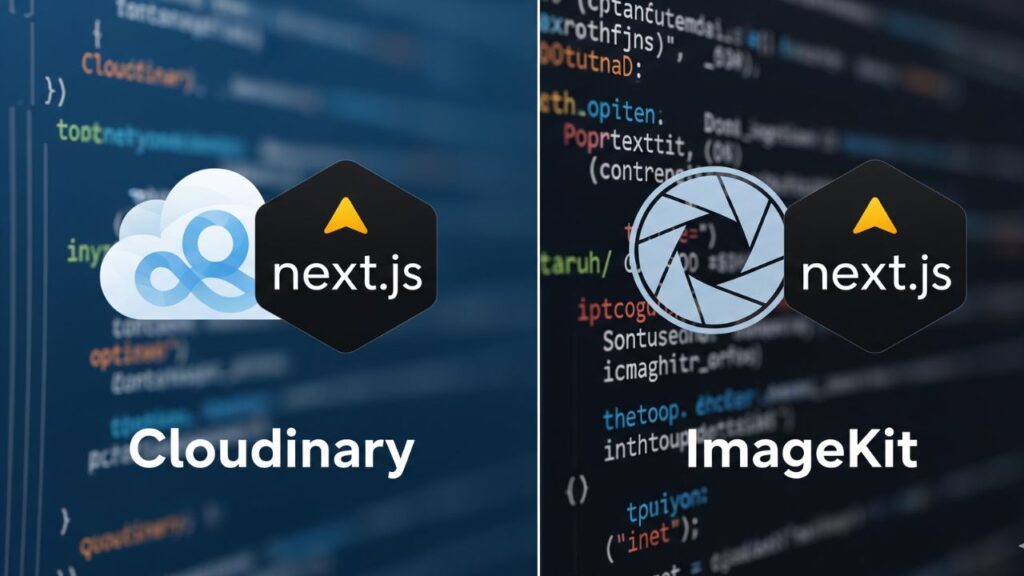Choosing the right image optimization service for your Next.js application can make or break your site’s performance.
With page speed being a critical ranking factor and user experience driver, the decision between Cloudinary and ImageKit isn’t just technical—it’s business-critical.
This comprehensive guide breaks down everything you need to know to make the right choice for your Next.js project.
Why Image Optimization Matters for Next.js Applications
Modern web applications handle massive amounts of visual content, and Next.js developers need solutions that can:
- Automatically optimize images for different devices and screen sizes
- Deliver content globally with minimal latency
- Handle dynamic transformations without server overhead
- Integrate seamlessly with Next.js’s built-in Image component
- Scale cost-effectively as your application grows
Both Cloudinary and ImageKit solve these challenges, but they approach them differently. Let’s dive deep into what makes each unique.
The Platforms: Cloudinary vs ImageKit Overview
🚀 Cloudinary
The Industry Pioneer
Cloudinary has been the gold standard in media management since 2012. It’s a comprehensive cloud-based platform that handles everything from basic image optimization to advanced AI-powered transformations.
- 25GB free storage + 25GB bandwidth
- Advanced AI features (background removal, auto-tagging)
- Video processing capabilities
- Extensive transformation library
- Enterprise-grade features
⚡ ImageKit
The Performance Challenger
ImageKit emerged as a developer-friendly alternative, focusing on simplicity, performance, and transparent pricing. It’s built specifically for modern web development workflows.
- 20GB free bandwidth + 20GB storage
- URL-based transformations
- Six processing regions globally
- Simple, predictable pricing
- Excellent developer experience
Pricing Comparison: The Numbers That Matter
Pricing is where these platforms diverge significantly. Understanding the cost structure is crucial for making an informed decision.
Free Tier Comparison
| Feature | Cloudinary Free | ImageKit Free |
|---|---|---|
| Monthly Bandwidth | 25GB | 20GB |
| Storage | 25GB | 20GB |
| Transformations | 25,000/month | Unlimited |
| Video Processing | 500 seconds | 25 VPU (~125 seconds SD) |
| AI Extensions | Limited | 25 units/month |
| Custom Domain | ❌ | ❌ |
Paid Plan Pricing
Cloudinary Plus: $89/month
- 100,000 total credits
- Storage: ~100GB
- Bandwidth: ~100GB
- Transformations: ~100,000
- Video: 2,500 seconds
- Add-ons available
ImageKit Pro: $89/month
- 225GB bandwidth (base)
- 225GB storage (base)
- Unlimited transformations
- 5,000 video processing units
- 4,000 AI extension units
- Custom domain included
🔥 Critical Difference: Pricing Model
Cloudinary uses a complex credit system where storage, bandwidth, and transformations all consume from the same pool of credits. This makes cost prediction difficult.
ImageKit uses simple component-based pricing. You pay separately for bandwidth, storage, and processing—making costs predictable and scalable.
Feature-by-Feature Comparison
| Feature | Cloudinary | ImageKit | Winner |
|---|---|---|---|
| Image Transformations | 300+ operations | 50+ operations | Cloudinary |
| Video Processing | Advanced (AI-powered) | Basic to Good | Cloudinary |
| Pricing Transparency | Complex credit system | Simple component pricing | ImageKit |
| Global CDN | Multiple providers | 450+ edge locations | Tie |
| API Documentation | Comprehensive | Developer-friendly | Tie |
| Next.js Integration | Official SDK | URL-based (simple) | Tie |
| Customer Support | Good (enterprise focus) | Excellent (<1 hour response) | ImageKit |
| AI Features | Extensive | Basic | Cloudinary |
| Storage Flexibility | Cloud-based only | External storage support | ImageKit |
Next.js Integration: How Easy Is Implementation?
Both services integrate well with Next.js, but the approaches differ significantly. Let’s look at practical implementation examples.
Setting Up Cloudinary with Next.js
// 1. Install the package
npm install cloudinary @cloudinary/react @cloudinary/url-gen
// 2. Configure Next.js (next.config.js)
module.exports = {
images: {
domains: ['res.cloudinary.com'],
loader: 'cloudinary',
path: 'https://res.cloudinary.com/your-cloud-name/image/upload/',
},
}
// 3. Basic usage in components
import { CldImage } from '@cloudinary/react';
export default function MyComponent() {
return (
<CldImage
src="sample"
width={400}
height={300}
alt="Sample image"
crop="fill"
gravity="auto"
/>
);
}Setting Up ImageKit with Next.js
// 1. Install the package
npm install imagekitio-react
// 2. Configure Next.js (next.config.js)
module.exports = {
images: {
domains: ['ik.imagekit.io'],
loader: 'custom',
loaderFile: './imagekit-loader.js',
},
}
// 3. Create ImageKit loader (imagekit-loader.js)
export default function imagekitLoader({ src, width, quality }) {
const params = [`w-${width}`];
if (quality) {
params.push(`q-${quality}`);
}
return `https://ik.imagekit.io/your_imagekit_id/tr:${params.join(',')}/${src}`;
}
// 4. Basic usage in components
import { IKImage } from 'imagekitio-react';
export default function MyComponent() {
return (
<IKImage
urlEndpoint="https://ik.imagekit.io/your_imagekit_id"
src="/sample.jpg"
width={400}
height={300}
alt="Sample image"
transformation={[{
width: 400,
height: 300,
crop: 'maintain_ratio'
}]}
/>
);
}Advanced Next.js Integration Examples
Responsive Images with Cloudinary
import { CldImage } from '@cloudinary/react';
export default function ResponsiveImage() {
return (
<CldImage
src="hero-image"
width={1200}
height={600}
alt="Hero image"
sizes="(max-width: 768px) 100vw, (max-width: 1200px) 50vw, 33vw"
crop="fill"
gravity="auto"
format="auto"
quality="auto"
/>
);
}Responsive Images with ImageKit
import { IKImage } from 'imagekitio-react';
export default function ResponsiveImage() {
return (
<IKImage
urlEndpoint="https://ik.imagekit.io/your_imagekit_id"
src="/hero-image.jpg"
width={1200}
height={600}
alt="Hero image"
transformation={[{
width: 1200,
height: 600,
cropMode: 'extract',
format: 'auto',
quality: 'auto'
}]}
loading="lazy"
/>
);
}Performance Comparison: Real-World Results
Based on independent testing and user reports, here’s how both services perform in real-world Next.js applications:
🏆 ImageKit Performance Wins
- Page weight reduction: 30%+ average
- Time to First Byte: Better globally due to 6 processing regions
- CDN performance: 450+ edge locations
- Bandwidth efficiency: Only charges for delivered file size
🚀 Cloudinary Feature Wins
- Transformation variety: 300+ operations available
- AI capabilities: Advanced background removal, auto-tagging
- Video optimization: Industry-leading video processing
- Format support: Broader range of input/output formats
Use Case Scenarios: Which Should You Choose?
🎯 Choose ImageKit When:
- Budget-conscious projects: Predictable, transparent pricing
- High-traffic applications: Better cost scaling for bandwidth
- Global applications: Superior global performance
- Developer-focused teams: Simple API, excellent docs
- Existing storage systems: Can work with your current infrastructure
- Startups and agencies: More cost-effective as you scale
🚀 Choose Cloudinary When:
- Advanced media needs: Complex transformations and AI features
- Video-heavy applications: Industry-leading video processing
- Enterprise applications: Mature platform with enterprise features
- E-commerce platforms: Advanced product image capabilities
- Marketing-heavy sites: AI-powered creative tools
- Established businesses: Can absorb higher costs for premium features
Migration Guide: Switching Between Services
Already using one service and considering a switch? Here’s how to migrate effectively:
From Cloudinary to ImageKit
// 1. Set up ImageKit as origin with Cloudinary URLs
// This allows gradual migration without breaking existing URLs
// 2. Update your loader function
function cloudinaryToImageKit(src, width, quality) {
// Handle existing Cloudinary URLs
if (src.includes('res.cloudinary.com')) {
const imagePath = src.split('/upload/')[1];
return `https://ik.imagekit.io/your_id/tr:w-${width},q-${quality || 75}/${imagePath}`;
}
// Handle new ImageKit URLs
return `https://ik.imagekit.io/your_id/tr:w-${width},q-${quality || 75}/${src}`;
}
// 3. Gradually update components to use ImageKit directly
// Old: res.cloudinary.com/demo/image/upload/sample.jpg
// New: ik.imagekit.io/your_id/sample.jpgFrom ImageKit to Cloudinary
// 1. Bulk upload existing assets to Cloudinary
// Use Cloudinary's admin API for bulk operations
// 2. Update your Next.js configuration
module.exports = {
images: {
domains: ['res.cloudinary.com'],
loader: 'cloudinary',
path: 'https://res.cloudinary.com/your-cloud-name/image/upload/',
},
}
// 3. Update component usage
// Old: ik.imagekit.io/your_id/tr:w-400/sample.jpg
// New: res.cloudinary.com/your-cloud/image/upload/w_400/sample.jpgAdvanced Implementation Tips
Optimizing for Core Web Vitals
Both services can help improve your Core Web Vitals, but implementation matters:
// Universal optimization settings for both services
const optimizationProps = {
priority: true, // For above-the-fold images
placeholder: "blur", // Reduces CLS
blurDataURL: "data:image/jpeg;base64,/9j/4AAQSkZJRgABAQAAAQ...", // Tiny base64 image
sizes: "(max-width: 768px) 100vw, (max-width: 1200px) 50vw, 33vw",
quality: 85, // Sweet spot for quality vs size
format: "auto", // Let service choose optimal format
}
// Apply to your Next.js Image components
<Image
src="/hero-image.jpg"
width={1200}
height={600}
alt="Hero image"
{...optimizationProps}
/>Handling Different Image Types
// Smart image optimization based on content type
function getOptimalSettings(imageType, useCase) {
const settings = {
'product': { quality: 90, format: 'auto', crop: 'pad' },
'thumbnail': { quality: 70, format: 'webp', crop: 'fill' },
'hero': { quality: 85, format: 'auto', crop: 'fill' },
'avatar': { quality: 75, format: 'auto', crop: 'thumb' }
};
return settings[imageType] || settings['product'];
}
// Usage in components
const settings = getOptimalSettings('product', 'gallery');
<OptimizedImage src={productImage} {...settings} />Cost Analysis: Real Numbers for Different Traffic Levels
Here’s a realistic cost comparison based on different traffic scenarios:
| Monthly Scenario | Cloudinary Cost | ImageKit Cost | Savings |
|---|---|---|---|
| Small Blog 50GB bandwidth, 10GB storage | $89 (Plus plan) | $0 (Free tier covers it) | $89/month |
| Medium E-commerce 200GB bandwidth, 50GB storage | $89 (Plus plan) | $89 (Pro plan covers it) | Tie |
| High-Traffic Site 500GB bandwidth, 100GB storage | $224+ (Advanced + overages) | $89 + $124 = $213 | $11+/month |
| Enterprise Level 2TB bandwidth, 500GB storage | $500+ (Enterprise pricing) | $89 + $855 = $944 | Varies |
💡 Pro Tip: Hidden Costs to Consider
- Cloudinary: Transformation costs, generated image storage, and bandwidth all share credit pool
- ImageKit: Transparent overages, but watch video processing units for video-heavy sites
- Both: Factor in developer time—ImageKit’s simpler pricing means less time managing costs
Developer Experience: What Really Matters
Having worked with both platforms, here are the real-world developer experience differences:
✅ ImageKit Advantages
- Setup time: 15 minutes vs 45 minutes
- Documentation: Clearer, more focused
- Support response: <1 hour average
- URL structure: More intuitive
- Billing dashboard: Crystal clear usage breakdown
- Migration tools: Built-in support for existing storage
✅ Cloudinary Advantages
- Feature depth: More transformation options
- Community: Larger ecosystem and tutorials
- Integrations: More third-party plugins
- AI capabilities: Industry-leading features
- Video processing: Advanced video optimization


